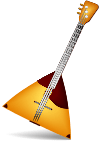Domra
 | |
| String instrument | |
|---|---|
| Classification | Plucked string instrument |
| Hornbostel–Sachs classification |
321.321 (Composite chordophone) |
| Playing range | |
 | |
| Related instruments | |
| Balalaika, Mandolin | |
The domra (Russian: домра) is a long-necked Russian string instrument of the lute family with a round body and three or four metal strings.
History
In 1896, a student of Vasily Vasilievich Andreyev found a broken instrument in a stable in rural Russia. It was thought that this instrument may have been an example of a domra, although no illustrations or examples of the traditional domra were known to exist in Russian chronicles. A three-stringed version of this instrument was later redesigned in 1896, patented, and introduced into the orchestra of Russian folk instruments.[1]
The three-stringed domra uses a tuning in 4ths.
Later, a four-stringed version was developed employing a violin tuning by Moscow instrument maker, Liubimov, in 1905.
In recent times, scholars have come to the conclusion that the term "domra" actually described a percussive instrument popular in Russia, and that the discovered instrument was either a variant of the balalaika or a mandolin.
Today, it is the three-stringed domra that is used almost exclusively in Russia. It is played with a plectrum, and is often used to play the lead melody in Russian balalaika ensembles.
Orchestral instruments
The basic domra is tuned as follows:
Instruments are made in various sizes including piccolo, prima, alto, tenor, bass, and contrabass.
- Piccolo: b1 e2 a2[2]
- Prima: e1 a1 d2[3]
- Soprano: b e1 a1[4]
- Alto: e a d1[5]
- Tenor: B e a[6]
- Bass: E A d[7]
- Contrabass (minor): 1E 1A D[8]
- Contrabass (major): 1A D G[9]
Performers
Tamara Volskaya is considered to be one of the leading contemporary performers on the domra. She is a Merited Artist of Russia, a Laureate of the USSR competition, and a Professor at the Mussorgsky Ural State Conservatory in Yekaterinburg, Russia. Other prominent domrists include:
- Tatjana Ossipova
- Michail Sawtschenko
- Viktor Kalinsky
- Victor Solomin
See also
References
- ↑ "Государственный академический русский оркестр им. В. В. Андреева".
- ↑ "Tablature for piccolo domra".
- ↑ "Tablature for prima domra".
- ↑ "Tablature for mezzosoprano domra".
- ↑ "Tablature for alto domra".
- ↑ "Tablature for tenor domra".
- ↑ "Tablature for bass domra".
- ↑ "Tablature for contrabass domra (the minor)".
- ↑ "Tablature for contrabass domra (the major)".
External links
| Wikimedia Commons has media related to Domra. |
